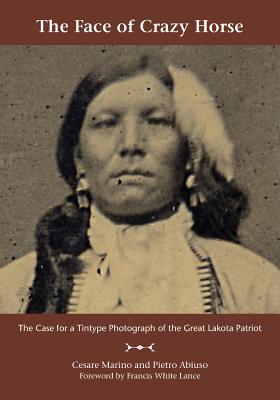First published in J.W. Vaughn's classic, With Crook at the Rosebud more than sixty years ago, the
"Crazy Horse" tintype has long been the subject of controversy. Most Indians and non-Indians have denied the existence of any possible photographic portrait of the Lakota mystic warrior, including the tintype. With an open-minded approach, The Face of Crazy Horse looks at the photographic history of the Lakota and at Crazy Horse "the man," debunking the false myths created around the heroic figure of the Oglala war chief; including Crazy Horse's refusal to be photographed for fear his soul would be stolen, and the frozen view of
Crazy Horse's unrelenting hatred of the White man. Contextual historical and photographic evidence, and a detailed analysis of the debated image, overall appearance, facial features, clothing, medicine bundle, breast-plate, and accessories, provide convincing evidence that the tintype indeed portrays the face and full portrait of Crazy Horse. This identification has long been supported by affidavits and testimonies from within the Lakota community, foremost those of Mrs. Ellen Howard, Jake Herman, and Dewey Beard (aka Iron Hail), and more recently by Francis White Lance and others.

The Face of Crazy Horse: The Case for a Tintype Photograph of the Great Lakota Patriot
First published in J.W. Vaughn's classic, With Crook at the Rosebud more than sixty years ago, the
"Crazy Horse" tintype has long been the subject of controversy. Most Indians and non-Indians have denied the existence of any possible photographic portrait of the Lakota mystic warrior, including the tintype. With an open-minded approach, The Face of Crazy Horse looks at the photographic history of the Lakota and at Crazy Horse "the man," debunking the false myths created around the heroic figure of the Oglala war chief; including Crazy Horse's refusal to be photographed for fear his soul would be stolen, and the frozen view of
Crazy Horse's unrelenting hatred of the White man. Contextual historical and photographic evidence, and a detailed analysis of the debated image, overall appearance, facial features, clothing, medicine bundle, breast-plate, and accessories, provide convincing evidence that the tintype indeed portrays the face and full portrait of Crazy Horse. This identification has long been supported by affidavits and testimonies from within the Lakota community, foremost those of Mrs. Ellen Howard, Jake Herman, and Dewey Beard (aka Iron Hail), and more recently by Francis White Lance and others.